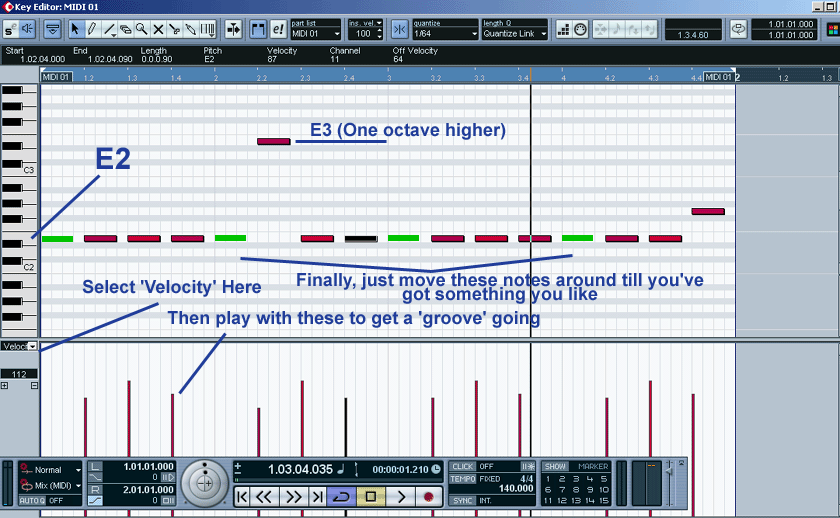:goodthre:
Well here's a topic and a half!!
Don't worry I don't have a midi controller either, or a keyboard or monitors, you don't
really need them. :runsmile:
First thing I'll mention is that it is very difficult to get a good bass line without a good kick (and vice versa) so I'd work on both at the same time if you can, as they need to work together.
If you are still lacking a
great kick,
>>>here<<< is one I knocked up which will do for now. One thing at a time eh

in terms of patterns
try and avoid putting bass notes at the same time as kick drums, as this gets very muddy, and difficult to control. It can be done to great effect, but it is very hard in my experience. That cuts things down quite a lot.
In terms of pure rythym:
For a decent, driving psy you may want to follow on of these patterns (1 bar, divided into 16's here, this is generally the way to go unless you are into dark soho)
//K-B-/K-B-/K-B-/K-B-//
or
//K-BB-/K-BB/K-BB/K-BB//
or
//KBBB/KBBB/KBBB/KBBB//
lots and lots and lots of tracks use this type of bass, although the first has fallen from favour somewhat over recent years, as it tends to make things sound a bit slooooooow. I favour the last one most of the time.
Now for the notes.
Well, I'm quite fond of one note bass lines which is fairly unimaginative I know but it gets the job done. This also makes it easy to figure out what key to write stuff in. If you want to add different notes in to get that rolling style bass like Sidhu uses so well, then you'll need to know your arpeggio's which are easy. In C, your primary notes of choice will most likely be C, Eflat, G and Bflat (although the Bflat will probably be an octave down and sometimes the G too, if you pull a bass part to far away from the note you originally built it on, it starts to sound funny for various reasons, mainly but not only EQ)
these intervals are in turn the root or tonic (C), the minor third (Eflat), the dominant or perfect fifth (G) and the minor 7th (BFlat - this is the one that makes it funky

) the rest are nice, but uneeded for now. Put these in just about any order you like, within the rythyms shown above it doesn't really matter, but remember for now, we are in C, so this should be the most frequent or at least first note that gets played, other wise, the bass will feel like it is in a different key to the rest of the piece.
Phew! Still with me ? Good ! :runaway: :runaway: :runaway: :sun:
Next - synthesis (gulp)
Well, it is no good having
just bass in your bass, or no-one is gonna hear it in the mix so the first thing to do is set up the filter. Now, a lot of this comes down to personal preference, so this isn't an exact science.
Get a synth with at least two oscillators for now
Osc 1 :Get a waveform with lots of harmonics. A saw will do nicely, or maybe a square wave (square waves tend to sound a bit more 'hollow').
Osc 2 : I'd go for a sine wave, as this will put in a nice fat bit of sub.although these can be tricky.
Set the amp section up so that the attack is as quick as possible, the decay is on nothing, the sustain is full and the release is on nothing. This means that the note will play straight away for the exact length of the note you write with now tail.
With the filter envelope firstly make sure that you have turned up the envelope modulation (probably near the cutoff) so that the envelope affects the cutoff, again have no attack or realease, but this time no sustain either. Now play with the cutoff and decay until you get a sound you like and sounds like the 'audible' bit of a psy bass line. A little resonance can help the sound come through the mix here, but not to much hey or you'll blow up things. Right. That should be pretty much it. the basic sound should be right, although you'll need to fine tune it. You may want to use decay on the oscillator amp instead of sustain if the note attack isn't clear.
if the synth is making a clicking noise try raising the attack and release just a little
Compression.
Get blockfish fish from
www.kvr-vst.com, while you're at it get Triangle II also, this is a great bass synth.
This is an easy to use, great sounding compressor fiddle about with it until you get sound you like. If you can't get the bass to come through clearly, try adding a little of it's analogue distortion, this will add upper frequencies to the signal which make it more audible.
EQ:
We are in C so...
a little bit around 130hz if you want to make it 'rounder' and a little bit around 35hz if you want it bassier. careful though, this can be
very difficult to judge!
phew, I'm parched. hope that made some sense!
i come out with something like
>>>THIS<<<
:sun: :sun: :sun:







